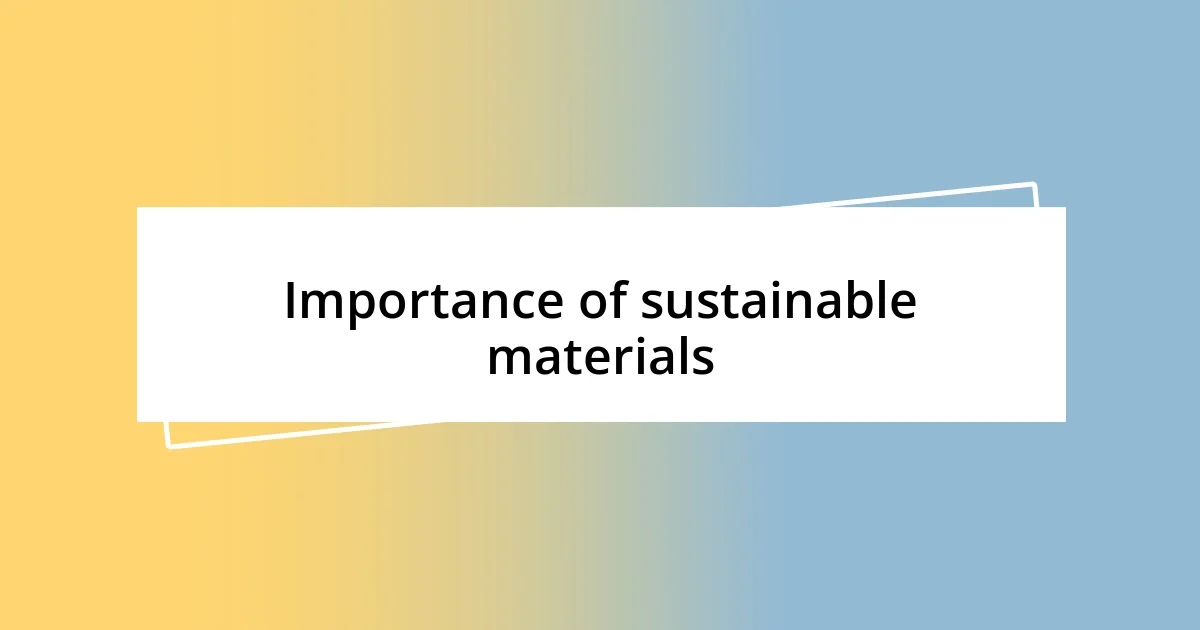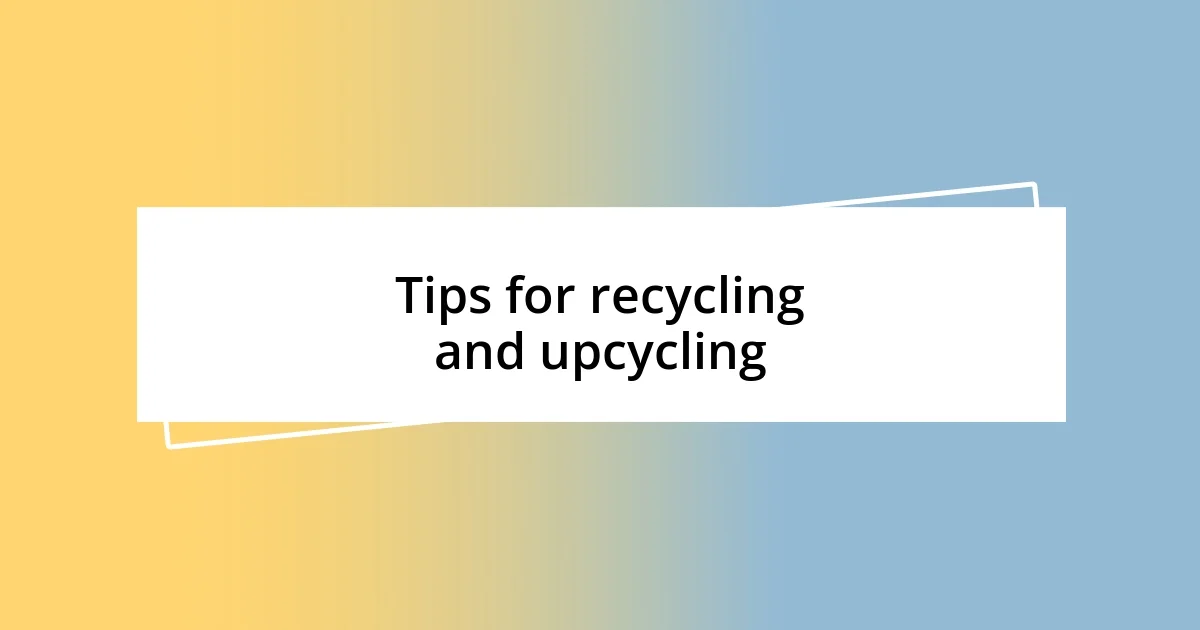Key takeaways:
- Circular fashion emphasizes durability, repairability, and recycling, fostering a sustainable relationship with clothing.
- Utilizing sustainable materials significantly reduces environmental impact and promotes ethical practices in the fashion industry.
- Engaging in mindful consumption and participating in clothing swaps enhances community connections while promoting sustainability.

Understanding circular fashion principles
Circular fashion principles center around keeping textiles in use for as long as possible. I remember a time when I felt overwhelmed by my overflowing wardrobe, realizing that I was part of a cycle that encouraged fast fashion consumption. Have you ever felt the weight of clothes you hardly wear? This realization pushed me to explore circular fashion—where the focus is on durability, repairability, and recycling.
At its core, circular fashion isn’t just about reducing waste; it’s about rethinking our relationship with clothing. I once encountered a designer who transformed discarded materials into stunning outfits, and it hit me—every garment can have a second life. Think about the last time you mended a piece of clothing; that simple act brought a sense of pride and connection to the fabric itself, didn’t it?
Understanding circular fashion means recognizing that every choice we make has an impact. For instance, I’ve started opting for brands that prioritize sustainability and ethical practices, feeling empowered with each purchase. It’s liberating to know I’m not just buying a product, but supporting a system that values the planet and its resources. How amazing is it to be part of something that goes beyond fashion, creating a ripple effect of positive change?

Importance of sustainable materials
Sustainable materials play a pivotal role in circular fashion, significantly reducing the environmental impact of our clothing. I recall the first time I purchased a shirt made from organic cotton; the softness felt incredible, but what struck me most was knowing I was supporting farming practices that didn’t rely on harmful chemicals. This choice made my wardrobe not just more stylish, but also an expression of my values.
Here’s why sustainable materials matter:
– Reduces Waste: Using recycled fibers helps divert textile waste from landfills.
– Conserves Resources: Sustainable materials often require less water and energy to produce.
– Supports Ethical Practices: Brands that utilize sustainable materials often have fair labor practices, allowing artisans to earn a living wage.
– Enhanced Durability: Many sustainable fabrics are stronger and longer-lasting, encouraging better care and repair habits.
– Positive Brand Impact: Choosing sustainable options encourages brands to shift towards more eco-friendly practices.
Every time I wear my organic cotton shirt, I feel a connection not just to the fabric, but to the broader community of conscious consumers striving for change. It’s about making choices that influence the industry and inspire others to embrace the beauty of sustainability.

Strategies for mindful consumption
Mindful consumption is all about the intentional choices we make regarding what we buy and how we use it. I vividly remember a shopping trip where I stood before a rack of fast fashion deals, feeling that familiar tug of temptation. But then, I took a step back and thought about the longevity of those pieces. When I shifted my focus to quality over quantity, I found that I not only felt more satisfied with my purchases but also less guilty about my impact on the environment.
Learning to consume mindfully has been an empowering journey. Instead of scrolling through endless online sales, I’ve started to curate my wardrobe with versatile staples that can be styled in multiple ways. I once purchased a timeless trench coat that, even years later, brings me joy and complements nearly every outfit. It’s these intentional purchases that allow me to remember each piece’s story and the thought that went into acquiring it.
I also practice the art of asking myself a few key questions before buying. Does this item align with my values? Will I wear it at least 30 times? This personal filter not only helps me resist impulse buys but also fosters a deeper appreciation for what I own. I find myself relishing the small victories of making mindful choices, reinforcing my commitment to circular fashion. How do you approach your purchasing habits?
| Strategy | Description |
|---|---|
| Intentional Shopping | Prioritize quality items that can last and be worn frequently to reduce overall consumption. |
| Wardrobe Curation | Focus on versatile staples that complement multiple outfits, creating a timeless collection. |
| Mindful Questions | Before purchasing, ask if the item aligns with your values and how often you’ll use it to ensure conscious consumption. |

Tips for recycling and upcycling
When it comes to recycling and upcycling, I’ve found that the key lies in creativity. One of my favorite projects was reworking an old pair of jeans into a trendy bag. I remember sitting on my living room floor, scissors in one hand and needle in the other, transforming what would have been waste into something functional and stylish. Have you ever thought about what pieces of clothing in your closet could use a little love?
Another vital tip is to embrace local craft communities. I often visit craft fairs where artisans showcase their upcycled creations. Once, I stumbled upon a beautiful lamp made out of discarded glass bottles. It was a positive reminder of how our throwaway items could be given new life. Supporting local makers not only helps reduce waste but also connects us to our communities – how often do we think about the stories behind the objects in our homes?
When it comes time to recycle, take a moment to research your options. I frequently check with local charities and textile recycling programs. One day, I discovered a nearby drop-off center for fabric scraps, which sparked a new routine for me. Now, rather than feeling guilty about leftover materials, I can contribute to a solution that keeps textiles out of landfills. The feeling of knowing I’m part of something bigger is incredibly satisfying—have you found places to recycle or upcycle in your area?

Creating a capsule wardrobe
Creating a capsule wardrobe has been a transformative experience for me. It’s not just about having fewer clothes; it’s about filling your closet with pieces you love and wear often. I remember when I finally let go of those “maybe” items that had been collecting dust. The sense of relief was immediate. It was a reminder that my wardrobe should reflect my personal style and values, not just trends.
The foundation of my capsule wardrobe is versatility. I focused on selecting key pieces that can be mixed and matched effortlessly. For instance, I have a favorite white button-up shirt that I can dress up with a skirt or down with jeans. Each time I put it on, I feel a rush of confidence knowing that I’m making conscious choices. It’s like unlocking a treasure chest of perfectly coordinated outfits without the overwhelm of too many options. Do you ever find yourself staring at a packed wardrobe but feeling like you have nothing to wear? I absolutely did until I embraced this minimal mindset.
Additionally, I’ve learned the art of seasonal review. At the end of each season, I take a moment to evaluate what worked and what didn’t. This process allows me to let go of items that no longer serve me while reaffirming my love for those that do. One year, I discovered that a lovely sundress I bought was rarely worn because it didn’t fit well with the other pieces in my wardrobe. By recognizing this, I was able to donate it to someone who might cherish it more. It’s a fulfilling cycle, ensuring that my capsule wardrobe stays fresh and true to who I am while benefiting others. Have you considered doing a seasonal refresh of your own wardrobe?

Supporting ethical brands
Supporting ethical brands has become a crucial part of my fashion journey. When I stumbled upon a local clothing brand that prioritizes sustainable materials and fair wages, I felt an immediate connection. I remember the excitement of wearing a soft, organic cotton tee while knowing that my purchase physically contributed to the livelihood of artisans. Isn’t it empowering to think that our choices can have such a direct impact?
I also cherish attending ethical fashion pop-ups. At one such event, I met the founder of a small brand who shared stories about sourcing materials from women-led cooperatives. Listening to her passion ignited a fire in me; I realized that every garment carries a story, and buying ethically means supporting those stories. Have you ever felt inspired by the narrative behind a piece of clothing?
As I continue to explore this realm, I pay close attention to brand transparency. A few months ago, I researched a favorite sustainable label and learned about their commitment to minimizing waste through closed-loop production. I was thrilled to discover that they offer take-back programs for worn-out items, a practice I’m eager to participate in. This level of commitment reassures me that my fashion choices align with my values—how does that resonate with you in your own shopping experiences?

Sharing and swapping clothing
Sharing and swapping clothing has opened up a refreshing way for me to connect with my friends and the community. I remember the excitement of organizing a clothing swap at my house. Everyone brought their favorites—those tops they loved but never wore anymore—and it felt like a mini fashion show. That sense of discovery was thrilling! It’s incredible how swapping clothes not only gives new life to garments but also fosters those social bonds.
Participating in local swap events has taught me a lot about the value of shared fashion knowledge. I found a chic blazer that someone was eager to pass on, and it quickly became a staple in my wardrobe. In these exchanges, I often find someone else’s outgrown treasure becomes my next go-to piece. Isn’t it fascinating how a single item can transform your style story while reducing waste in the process?
It’s more than just clothing—it’s about sharing stories and experiences. Recently, a friend and I swapped dresses for an evening. Each time I wore her dress, I felt the essence of her style, and it reminded me of our friendship. This practice makes me appreciate that fashion isn’t just about individual expression but also celebrating community. Have you thought about how sharing clothes could enrich your own wardrobe and connections?














